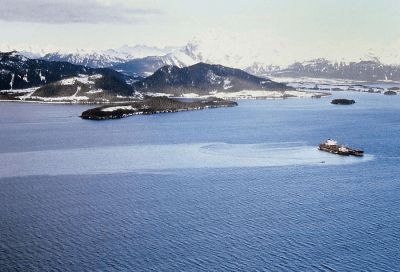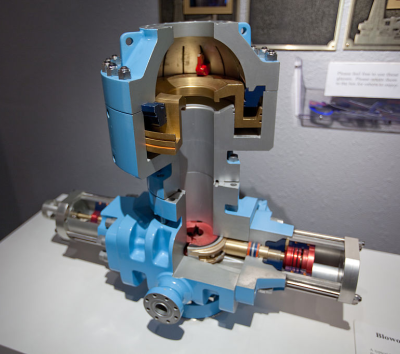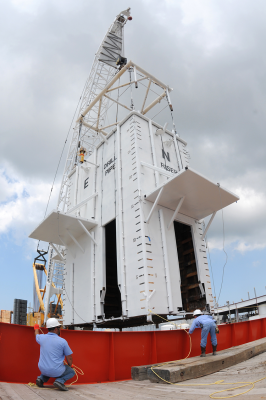Six years before Deepwater Horizon exploded in April 2010, the force of Hurricane Ivan blew an offshore drilling platform off its legs and into the Gulf of Mexico. For the last 14 years, that well’s pipes, long buried in mud and debris have been spilling oil into the Gulf every single day. That makes it the longest-running spill in history. Every day for fourteen years. Let that sink in for a bit.
Taylor Energy’s platform sat just 10 miles off the coast, much closer to the Louisiana shore than Deepwater Horizon was. Since the hurricane hit, Taylor has tried a number of unsuccessful things to stop the spill. They’ve only been able to plug 9 of the 25 broken pipes so far. The rest are buried deep in mud and debris. Why on Earth haven’t you heard about this before? Taylor spent six years covering it up. And they might have gotten away with it, too, if it weren’t for pesky watchdog groups surveying the Gulf after Deepwater Horizon exploded.
So how are oil spills stopped, anyway? The answer depends on many things. Most immediately, the answer depends whether the spill happened onshore or offshore, and the inciting incident that caused the spill. Underwater oil spills are much more difficult to stop because of the weight and existence of the ocean. In Taylor Energy’s case, the muddy Gulf bed has become a murky tomb for the broken and buried pipes, which makes it even more messy.

There’s More Than One Way to Spill Oil
Oil spills have many causes, and they run the gamut from pure accident to act of warfare. In 1989, the Exxon Valdez oil tanker ran aground thanks to broken radar and an absent captain. Pipelines break, underground storage tanks leak. Once in a while, tankers simply collide in the ocean.
The largest spill to date was done purposely by Iraqi soldiers during the Gulf War in a failed attempt to keep US Marines from descending upon the beaches. BP’s Deepwater Horizon rig exploded due to many factors, including a surge of natural gas.
The Taylor Energy platform was capsized by hurricane-force winds. Seems like an act of God, right? Yes, but there’s a little more to it than that. For one thing, the walls of the platform were planted several hundred feet down into mud. If you think that sounds like a bad idea, you’re right. The same risk that made it unwise to build the platform there makes it unsafe and difficult to deal with the spill.
According to LSU law professor Ed Richards, the risk is well known. And yet, many rigs dot this area of coastal Louisiana. When Hurricane Ivan came raging into the Gulf, the force of the waves turned the rig’s foundation into an underwater mudslide.

How to Stop the Hemorrhaging
Oil and gas wells are equipped with blowout preventers as a first line of defense. These are made up of special types of valves that can kill the well by severing the pipe. The blowout preventer is what should have saved Deepwater Horizon. When it exploded, a couple of crew members tried to engage the blowout preventer, which had failed to do so automatically.

The BP engineers tried to use underwater robots to trigger the blowout preventer, but a crucial valve was stuck and it didn’t work. Then they tried to lower a four-story steel containment dome over the whole thing. The idea was to trap the billowing plumes of oil and then vacuum them up. But fumes from the oil caused crystallization, and this produced gases that kept the dome buoyant. They also tried drilling relief wells with the ultimate intent of injecting mud and cement into the leaking well to seal it off.
Deepwater Horizon was a hot topic, so engineers tried everything short of nuclear weapons. Yeah, that’s a thing. The Russians have done it successfully at least three times, though all of those spills were onshore incidents. Basically, you drill an adjacent well at an angle and drop a nuke in it. The shock wave shifts and melts the surrounding rock, flattening the pipe and sealing off the well.
The viability of any given spill-stopping method depends on the situation. Underwater oil spills like Taylor Energy and Deepwater Horizon are much more difficult to monitor and fix than onshore spills. If you want a deep but comfortable dive into the gargantuan, months-long effort to stop the Deepwater Horizon spill, then check out this excellent coverage from the New York Times.

The Junk Shot and Three Views to a Kill
Some of the techniques for stopping spills have colorful names. Most of them aren’t environmentally friendly, but when you’re dealing with oil billowing into the ocean at an alarming rate, you’ll try almost anything. Engineers tried all of these and more to stop the BP spill.
The junk shot involves shooting junk, namely golf balls, tennis balls, shredded tires, and old, knotted-up rope into the blowout preventer. The idea is to clog it temporarily, and then start shooting mud and cement to stop it permanently. It sounds like a strange mix of wastefulness and re-use, but it worked to stop the 1991 spill in Kuwait.
Somewhere between the four-story steel box idea and the junk shot operation, those dealing with Deepwater Horizon tried something called the top kill. This involves pumping heavy mud through the blowout preventer and into the well to overcome the pressure of the rising oil.
They later tried the static kill, which is pretty much just top kill at a slower mud rate. Since the mud is much heavier, it will force the oil back down into the reservoir. Then it’s time to start pumping cement to seal it off.
Finally we come to the bottom kill. This one should have a different name, because it’s far more elegant than the other kills. Although things got a bit dodgy, it was the bottom kill that finally stopped Deepwater Horizon. First, engineers lower a magnetometer down a relief well. This induces a current in the well’s steel casing and generates a magnetic field, which helps engineers pinpoint the exact location of the leaking well. Then they drill into the hull of the leaking well and pump mud and cement down through the relief well to plug the leak.
Dealing with a Teenage Oil Spill
No two spills are the same, not even Deepwater Horizon and Taylor Energy. Deepwater Horizon spilled a lot of oil very quickly, and the oil was highly visible on the surface. The Taylor spill amounts to less than a gallon per day on the surface, but an estimated 100 barrels per day below the surface.
In 2008, Taylor set up a $666 million dollar trust to deal with the spill, and were bought out soon after by a pair of Korean companies. Since then, Taylor Energy has existed only to monitor the incident response. Studies done by the Coast Guard determined that the remaining 16 pipes posed little environmental risk, so Taylor sued the government to get the balance of their money back. Naturally, the government did a new study, and they determined that Taylor had under-reported the leak. Based on oil reserve estimates, they believe the leak could go on for 100 more years if no one is able to stop it.
A few months ago, the Coast Guard decided they would try the containment dome solution on the Taylor spill. Taylor Energy, which has been bankrupted down to a single employee, believes this will make the problem worse, so they decided to sue the Coast Guard.
Whether the Taylor spill can be stopped or not, there’s still the matter of all the oil polluting the oceans. There is one hope, though, and that’s oil-eating bacteria. One way of dealing with spills is to release dispersants into the water. These break down the oil globules so they can be consumed by certain types of bacteria that feed on hydrocarbons. It may not be the slickest solution, but it’s a start.
















“For one thing, the walls of the platform were planted several hundred feet down into mud. If you think that sounds like a bad idea, you’re right.”
What does this mean? That means nothing to me.
Basically, the oil rig was anchored to mud. Several hundred feet of mud, but still mud. This statement sums it up: “When Hurricane Ivan came raging into the Gulf, the force of the waves turned the rig’s foundation into an underwater mudslide.”
Generally you anchor walls and other building structures into bedrock, because dirt and mud have an unfortunate habit of moving. If you have pipes running from the surface down into the bedrock, and there’s a couple of hundred of feet of mud in between, then you shouldn’t try to anchor to the mud because when it eventually moves it’ll take your platform with it and rip the pipes off.
Founding a structure in sediment is pretty common, even onshore for bridges, etc. The problem in this case is that the sediment is in the river delta and subject to turbidity currents (underwater landslides). It’s analogous to designing a radio tower that can withstand being hit by an avalanche.
“In 2008, Taylor set up a $666 million dollar trust to deal with the spill, and were bought out soon after by a pair of Korean companies.”
We’re in the money! We’re in the money! Oh wait.
Does anyone think that the number “666” is a rather odd amount to set a trust up with??
Can anyone explain this:
“First, engineers lower a magnetometer down a relief well. This induces a current in the well’s steel casing […]”
The magnetometer surely doesn’t *produce* any significant current. Should this be a *magnet* ?
You can measure relative differences in magnetic fields, so there is a measurable difference between rock, casing, and casing with a significant deformation. Typically it’s the measurement of randomly polarized residual magnetism from the rocks vs. the highly ferrous casing that is much more polarized. There is also the possibility to induce polarization by injecting current.
Intereingly enoug, by dumb luck, my 8th grade science class toured the lab of one of the companies that operates the “bottom kill” equipment. (Vector Magnetics).
The missing piece is that they use the magnetometer to guide the steerable drill head toward the pipe in the burning/leaking/malfunctioning primary well.
Since many oil and gas wells are not drilled straight down but can wander/veer/route around hard to drill minerals (made with the same type of steerable bit) without the magnetometer it would be hard to drill a relief well that intercepts the main bore just a bit above the root (i.e. deep underground).
It is much more complicated than that. Vector Magnetics is the company that did most of the figuring out where the old well is. https://www.vectormagnetics.com/services/
The technology used is similar to drilling well pairs for Steam Assist Gravity Drain (SAGD) wells. SAGD wells are typically drill using a rotary magnet or active coil. Rotary magnet works best for ranging past an existing well because you start getting accurate measurements at ~50m from the second well. Using an active coil you need to be <20m from the second well. The typical well spacing is to have the steam well 5m above the producing well. At 5m separation the error in well spacing is less than the width of the bit 222mm (8-3/4"). Magnetic ranging has also been used to drill river crossings. In this case, http://www.tabpi.org/2005/f9.pdf, the rig were separated by gorge that was 300 m (984') deep and 2.8 km (1.7 miles) across. I've never used passive ranging, but if you're interested: https://patents.google.com/patent/US20140121971
IIRC, the inquiry revealed that the reason the Deepwater Horizon’s blowout preventer “failed to function” (in addition to a buckled pipe) is that the batteries were dead and it hadn’t been maintained.
https://www.workboat.com/news/offshore/deepwater-horizon-blowout-preventer-failed-due-to-unrecognized-pipe-buckling-report-says/
It did trigger, however. Only one of the batteries was dead. If it weren’t for the buckled pipe, it would have worked.
“It may not be the slickest solution…”
I see what you did there.
Leave it in the ground. Tends not to spill then.
What do we use instead, coal, wood, pixie pubes?
i prefer good clean nuclear, preferably breeder type reactor. perhaps one day we will consume all that spent fuel if we go that route.
Energy efficiency to reduce the need for oil, along with biofuels. There’s no excuse for new cars to not get at least 30 MPG highway.
I bet there are literally millions of excuses. Plus nunya.
Yes there is! Petroleum profit!
I had read years ago that Germany had produced a vehicle that got some 130+ MPG and that was before WW2.
Before “Fuel Injectors” and O2 sensors, you could add a tablespoon of acetone to your car’s gas tank and get a 30% increase in gas mileage. I tested this in my lawn-mower and it is true. I got about 30% more run time. These days, with cars, you can’t do that because the fuel/air mixture is under computer control insuring you DON’T get more that 30’ish MPG.
Globally, we’re all STILL hostages to profiteering and debt slavery. You think that’s *real* money you have in your pocket (I carry a 1923 silver dollar in my pocket). Nope! Its a “note” a.k.a. an IOU.
It’s not a matter of opinion that the great majority of fossil fuels must be kept in the ground in order to avert +2ºC of warming. It’s a fact. It is uncontroversial to state that we must move to sustainable energy, of which nuclear may be part of that mix, but renewable energy will be the bulk; is now already cheaper than many sources and will outcompete them all fairly soon (because fossil fuel extraction is getting more expensive, while renewables are getting cheaper).
But yes, you can imagine it’s pixie pubes if you like, perhaps Hackaday will run an article on your new energy source ;-)
There are many natural seeps of oil in the Gulf of Mexico and other under water deposits. That’s how many drilling locations are chosen – by finding a good sized natural seep and drilling there. Some California beaches have tar balls washing up. They come from natural oil seeps. Those tar balls got traced to their origin, wells were drilled and oil was pumped out for years, The tar balls stopped washing ashore because the pumping reduced the pressure in the oil deposits. But then the “green” politicians got the pumping stopped and the tar balls returned. They feared a broken pipe and a spill, but caused a return of oil leaking into the ocean.
And lighting causes thousands of wildfires every year. That doesn’t mean we shouldn’t regulate if / where hikers can have camp fires.
“the “green” politicians.. feared a broken pipe and a spill”
You mean the vast majority of climate scientists used evidence and reason to conclude that burning fossil fuels is unsustainable for the planet. The problem isn’t that pipes can burst, it’s that we’re drilling for oil and burning it and because you actually admit the industry drills for oil you therefore admit that it takes far more out of the ground than naturally occurs in the form of tar balls etc. Please don’t write misleading comments.
By not drilling for it, there is no need for pipes to transport it, and non-existent pipes don’t spill.
This is completely inaccurate. The Santa Barbara Channel (that’s the area you’re referring to) has always had oil seeps and tar balls. They were there in the 70s AFTER nearly all the drilling was stopped due to the catastrophic spill that was the impetus for much of the environmental legislation that was enacted in the early 70s. The seeps continued until this day. The main reason for the lack of drilling is that the area was just “played out” and so close to shore (you can easily see the old rigs from shore today) that when (not if) a spill occurred, the cleanup cost would be enormous so companies mostly left (risk vs reward). However, some drilling continued as we saw from the Refugio spill in 2015 where a pipe, bringing oil to shore, broke on-shore but leaked out into the SB Channel. That was “only” about 3400 barrels (142000 gallons). That’s all shut down because ops were $1M/day and revenue was less. LA Times did an in-depth article on the entire oil situation in SB Channel this year if anyone is interested. I worked in the spill tracking and monitoring world until this year….working with Fed,state,USCG, oil co’s etc
Kind of hard to get petrochemicals by leaving the oil in the ground. What? You all only thought oil was good for burning?
“You all only” are you using the American second person plural pronoun?
I didn’t think oil was only good for burning, I took chemistry in secondary school. I wonder how much the demand for oil would change if the need to burn oil would change. We could construct long chain hydrocarbons from the shorter chain hydrocarbons that are currently burnt.
Depending on the geology oil and gas can come to surface in the same way that an artesian water well flows. Do a search for oil seeps or see this https://en.wikipedia.org/wiki/Petroleum_seep.
Why not stop it the way we free’d Tibet? Bumper stickers!
15 years.
I love the response of these companies. If you don’t like it, sue.
Used to tie the problem up for years with no progress towards a real solution. In that time the company has examined the probability of winning/losing, transferred all assets to a safe haven, and declared bankruptcy.
At least one solution to this exists: companies doing something that has a decent chance of causing an expensive environmental catastrophe have to put money into a cleanup fund before they get to start operations. Then, if and when they successfully shut the operation down, they get their money back. This used to be required in some natural extraction industries but has generally vanished under pressure from the companies because they claim they won’t be able to make a profit. To me, if you can’t afford to clean up your mess, you shouldn’t get to make a mess. But that doesn’t seem to be a very popular viewpoint.
I find these videos pretty informative. CSB – Deepwater – https://www.youtube.com/watch?v=FCVCOWejlag
Related – the Keystone pipeline (built 2006) leaked over 380,000 gallons of oil into a North Dakota wetland last week…
https://time.com/5716106/keystone-pipeline-leak/
… and as of today, they still haven’t found where it leaked from.
https://www.reuters.com/article/us-keystone-pipeline-spill/keystone-oil-pipeline-in-north-dakota-remains-closed-leak-source-unclear-idUSKBN1XE204
… wtf?
It totally confounds me that current pipeline technology and/or practice can’t detect and prevent such leaks. Maybe a subject for another HaD article?
The Taylor Energy story is a very sad one. They are the company that seriously took it as the personal objective to solve this problem. The innovation and new technologies they helped create were astounding. Mrs. Taylor is a hero in my book. Drilling a new well from miles away to a well which the top was ‘lost’ in mud with uncertain location, orientation, etc. Getting within inches of it while completely parallel. Amazing to this day.